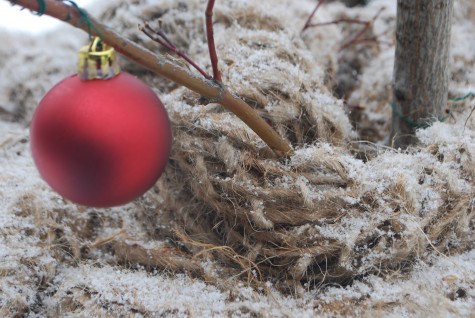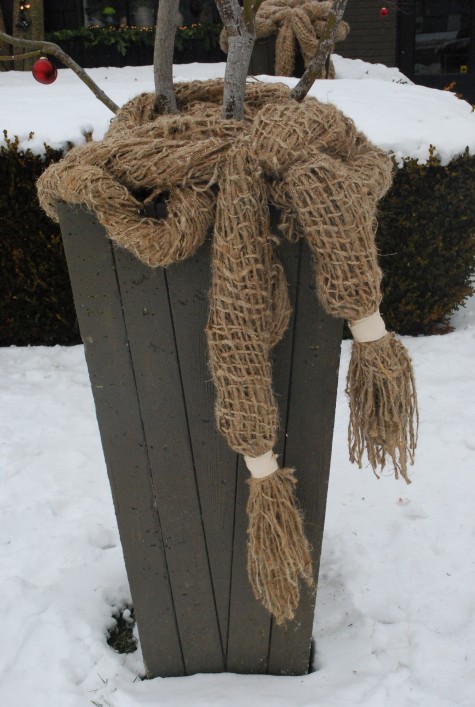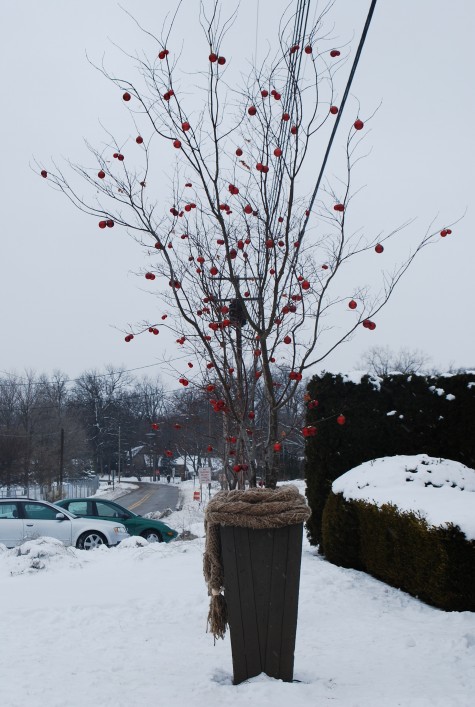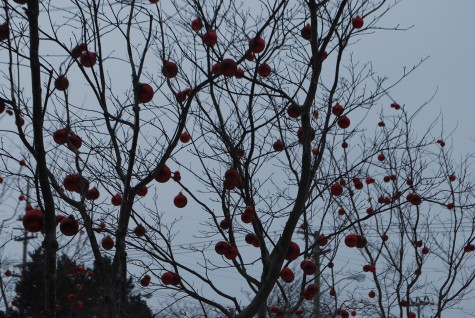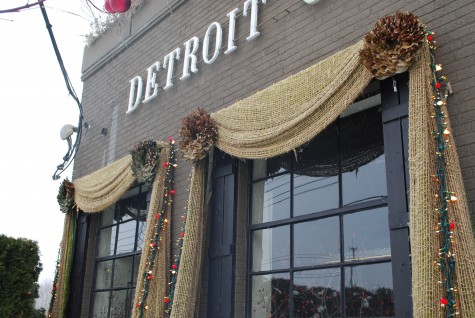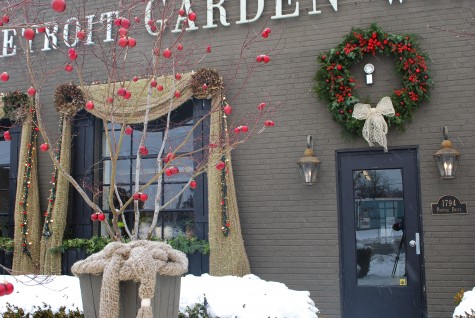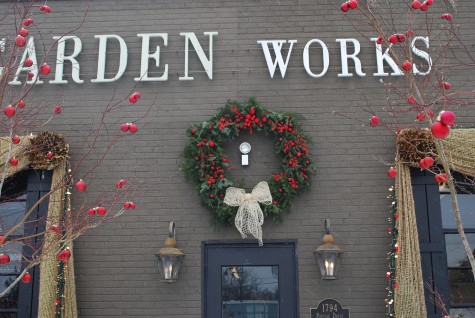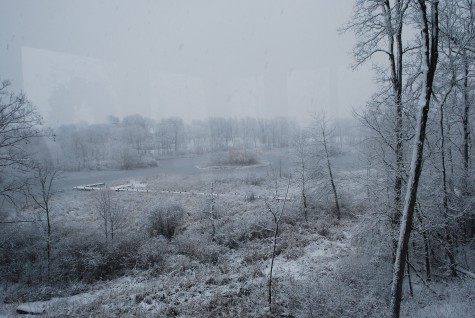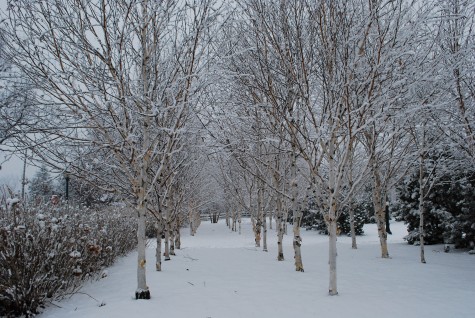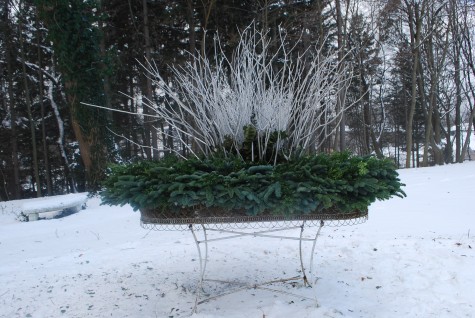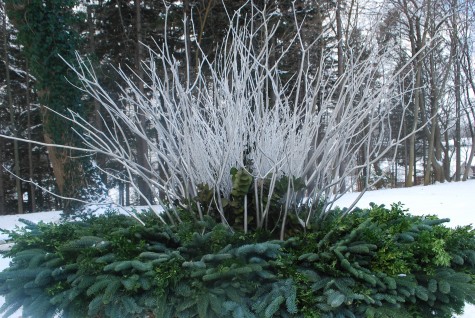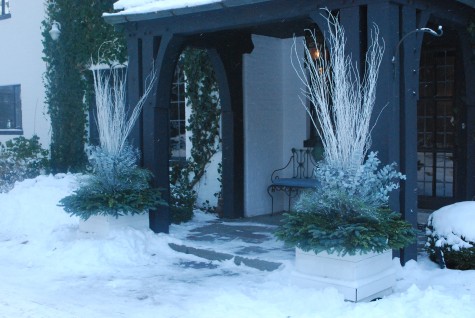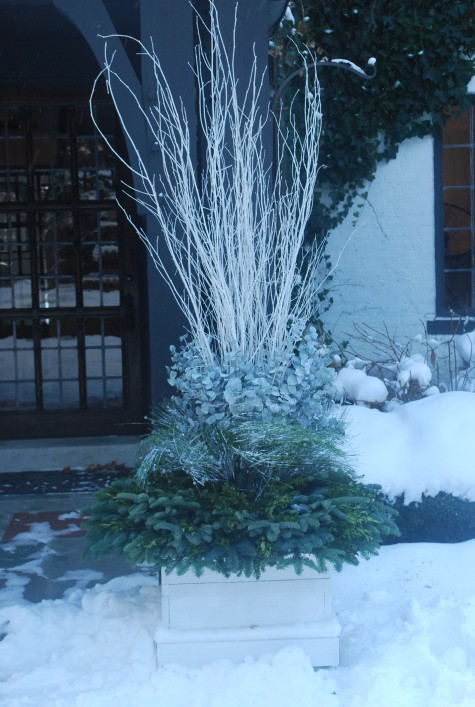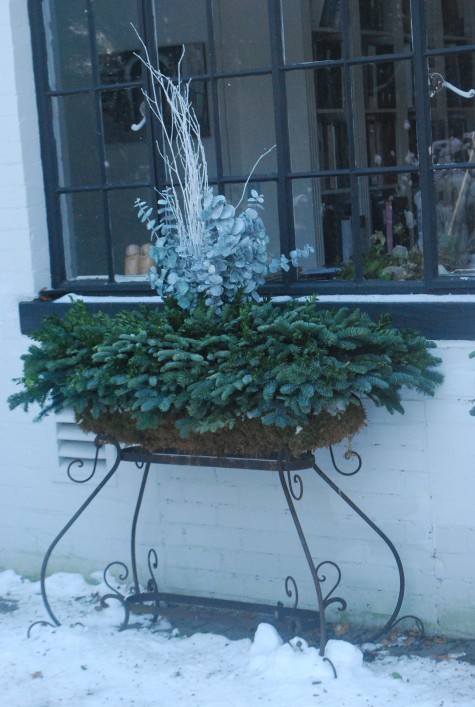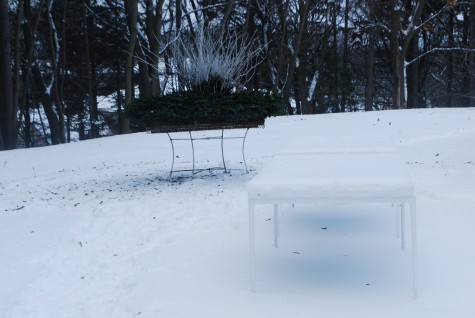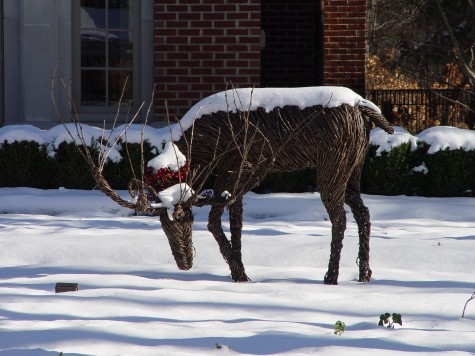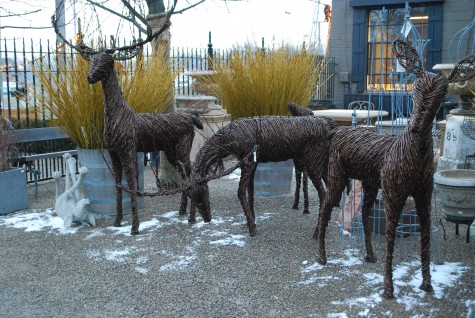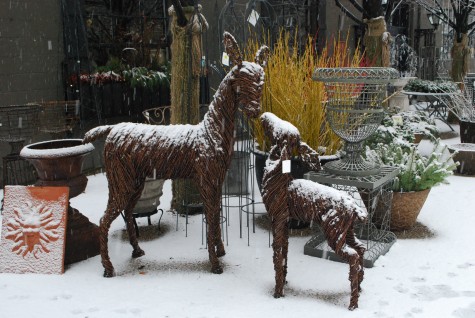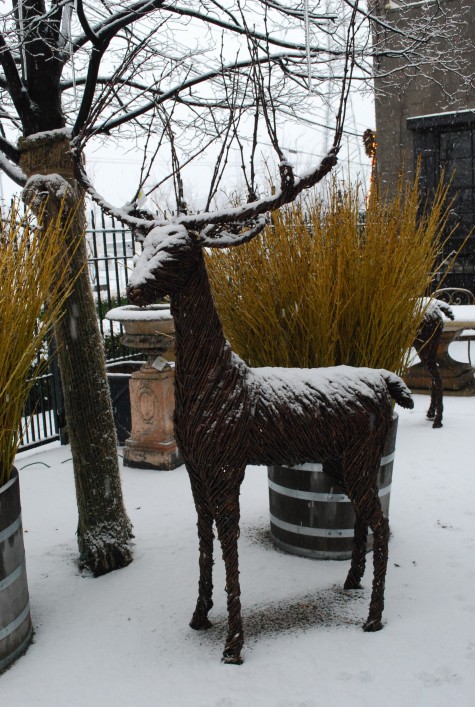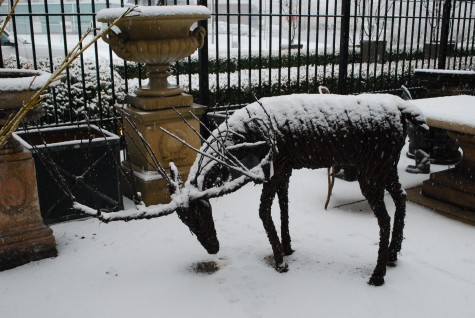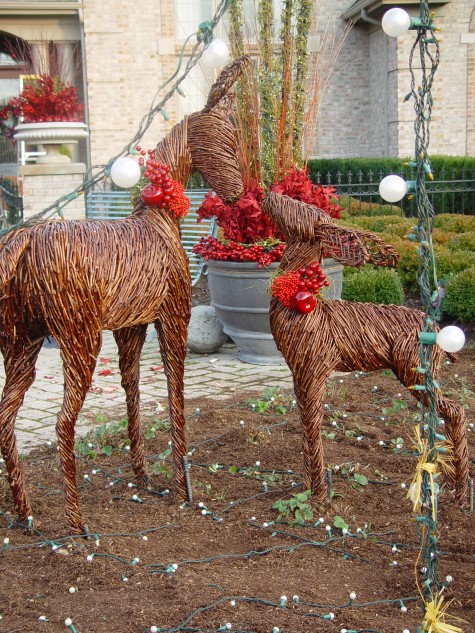The Berries
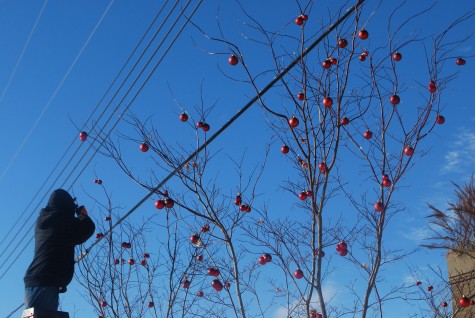
Once it was decided to express a little holiday red, it seemed only natural to add berries to my Japanese maple branches. It took an entire day to get them ready to hang. With the temps in the teens, one hopes for an installation that is easy to manage with gloves on, and with dispatch. Glass ornaments are fine outdoors-as long as no water gets inside, and freezes. I had no interest in exploding berries. So the caps were glued on all the way around, and the holes in the top around the hanger were sealed shut with glue. Then a florist’s wire was attached to each berry or berry cluster. I would guess we glued and wired about 600 ornaments.
 Each tree had its own bucket of ornaments; I asked for the help of both the landscape crew and the shop people-so no one would have to be outdoors too long. As it turned out, the south side of the building on a sunny day is not too bad. It always seems like I have way too many ladders, until I have a project like this. My only regret here-the need to disturb my snow blanket. One sure sign of a gardener-that person who does not permit the mailman to trudge across the front yard through the snow. “Please use the side walk sir.” I do like looking at my fresh and unsullied snow.
Each tree had its own bucket of ornaments; I asked for the help of both the landscape crew and the shop people-so no one would have to be outdoors too long. As it turned out, the south side of the building on a sunny day is not too bad. It always seems like I have way too many ladders, until I have a project like this. My only regret here-the need to disturb my snow blanket. One sure sign of a gardener-that person who does not permit the mailman to trudge across the front yard through the snow. “Please use the side walk sir.” I do like looking at my fresh and unsullied snow.
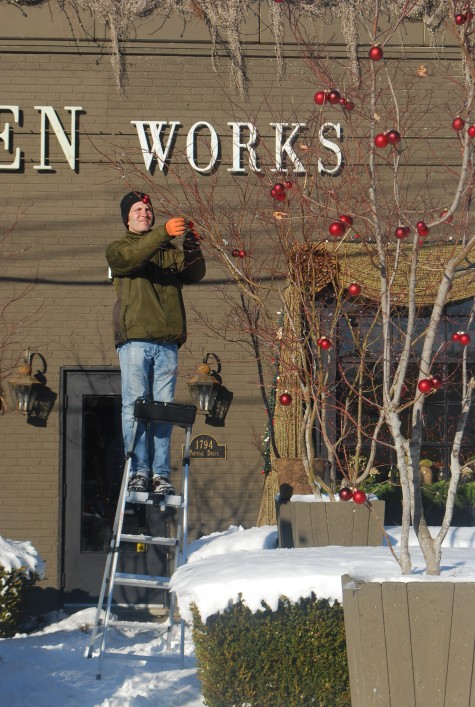
Rob has no qualms about perching on a ladder listing to the east, as you can see. He is also plenty tall enough to get some of the ornaments up high. Good design is not necessarily complicated-an edited and simple gesture can be just grand. It just means that all of the effort it took to produce that gesture came ahead of the display, and is not visible. I am not so good at editing at the holidays; I like to add, and then add a little more. Getting the ornament to the tops of these trees is about making an effort. Sometimes a solid effort is sometimes all you need to bring a smile to someone’s face.
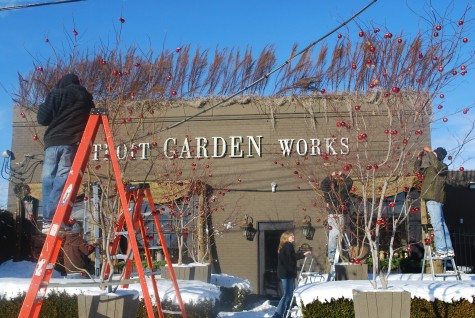 The entire process went much faster than I thought. A holiday orchard was just about complete.
The entire process went much faster than I thought. A holiday orchard was just about complete.
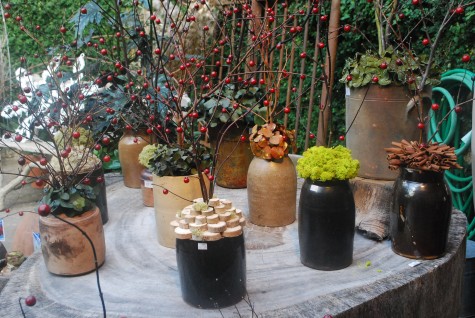 Should I get to the office later than Steve in the morning, he will have turned on the lights. It is dark late into the morning now. The past few weeks I have been noticing all the bits and pieces I have placed in the windows. I finally noticed all of that was apparent from the street. I have 4 large scale factory windows with sills a foot deep. These surfaces had accumulated all manner of unrelated objects that just needed to be put away. In short, my window sills had that littered look. With the remaining Japanese maple branches, Pam and I dressed a collection of vintage American jars with small holiday topiaries. I glued on the berries; Pam did the bottoms. We did 26 in all.
Should I get to the office later than Steve in the morning, he will have turned on the lights. It is dark late into the morning now. The past few weeks I have been noticing all the bits and pieces I have placed in the windows. I finally noticed all of that was apparent from the street. I have 4 large scale factory windows with sills a foot deep. These surfaces had accumulated all manner of unrelated objects that just needed to be put away. In short, my window sills had that littered look. With the remaining Japanese maple branches, Pam and I dressed a collection of vintage American jars with small holiday topiaries. I glued on the berries; Pam did the bottoms. We did 26 in all.
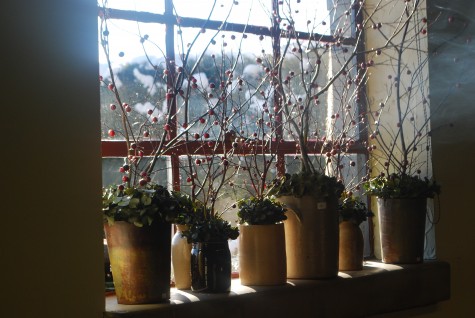
The three windows facing the front are now jammed with these jars. The thicket of berried branches looks good on my side of the glass.
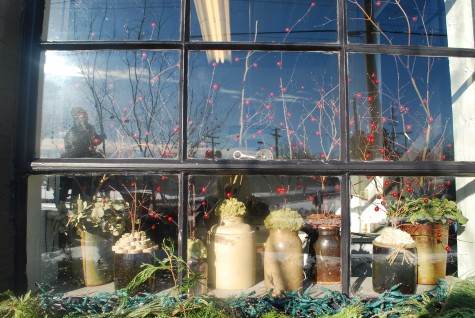 From outside, the look is much improved. Sometimes the smallest change can make a big impact. Changing what I have become used to is the toughest change to make. What is familiar has a way of hanging on with me.
From outside, the look is much improved. Sometimes the smallest change can make a big impact. Changing what I have become used to is the toughest change to make. What is familiar has a way of hanging on with me.

All of the big berries in the big trees, and the mini-berries in the little trees are out there-now what?
Deer In The Garden
The idea of sculpture in a garden greatly appeals to me. Not that I mind museums. I was taken regularly as a child. If you pushed me, I could describe certain rooms, paintings and sculptures at the Detroit Art Institute fairly accurately. The medieval sculptures of the saints-my Mom could never figure out why I always wanted to go there first. As an adult, in my top ten list of most memorable experiences include the Caravaggio exhibition at the Met in NYC in 1985, and the Lucien Freud exhibition at the Met in 2000. Unforgettable. These exhibitions were worth driving to New York to see.
But given my choice, I would prefer to be standing in a meadow over a museum. In a gully over a gallery. An art object that keeps me company outdoors-this I really like. I have seen Henry Moore sculptures outdoors in both private and public collections. In the mid 80’s I lived in New York just one block from a Richard Serra sculpture-not that it moved me particularly. But there it was, in the landscape. The lion sculptures outside Tiger stadium delight both the kids and adults that see them.
This is all by way of saying that I have had exposure to fine art in museums, galleries, private homes, and parks. I happen to believe that fine art is all around me, outdoors. Lots of that-courtesy of nature. Shopping for a client recently, I parked my car near a row of mature Bradford pears wreathed in nut brown fruit. I had never really looked at that fruit before. If you are the person that was waving me out of the road that day-I can only say those trees laden with fruit stopped me in my tracks.
A Henry Moore sculpture is not in my future-no matter. Sculptures made from grapevine would fit right into my garden. These life size grapevine deer are made in California-woven over steel armatures. The standing Buck, the grazing Buck, the doe and the fawn-what garden does not have room for one, or a group of them? Some may say they are craft-and they are finely crafted. But I don’t find the need to make that distinction.
Some sculpture might never be at ease in a garden. But these grapevine deer seem to make themselves right at home. I suppose that is as much about the material as it is about the subject matter. Grapevine is a wiry and sturdily independent material. How this California company manages to make sculpture from rigid welded steel forms and wild vines-astonishing. Grapes grow independent of your issues, or mine. Constructing sculpture from such a willfully uncooperative material cannot be that easy. No grapevine grows parallel to its neighbor. These deer sculptures may not be within shouting distance of a Henry Moore sculpture, but they please me.
Sculptures such as these easily accommodate a little holiday decoration. Each figure is hand made, and assembled by one artist from start to finish. The grapevine is thoroughly sealed to prevent the vine from deteriorating. This needs be be repeated once a year.
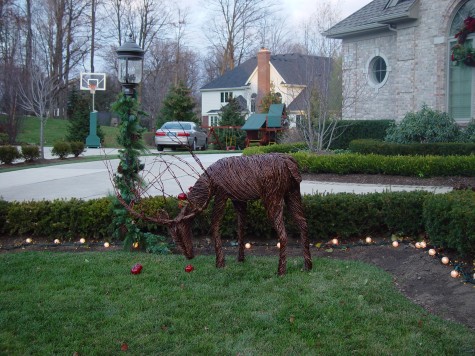
If I had to have a deer in my garden, this would be my species of choice. If you have an interest in acquiring one or many, we do stick them at Detroit Garden Works. The Grapevine Deer
